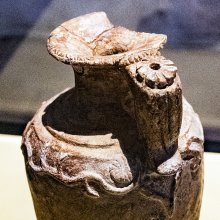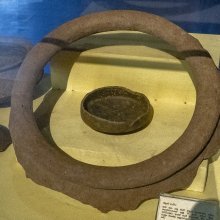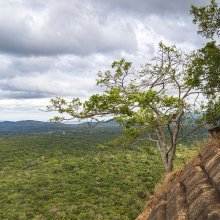Anuradhapura, Anurādhapura, Anuradha-pura: 8 definitions
Introduction:
Anuradhapura means something in Hinduism, Sanskrit, the history of ancient India. If you want to know the exact meaning, history, etymology or English translation of this term then check out the descriptions on this page. Add your comment or reference to a book if you want to contribute to this summary article.
Images (photo gallery)
(+10 more images available)
India history and geography
Source: archive.org: Ceylon Branch of the Royal Asiatic Society 1963The tradition is that Anurādhapura was first founded as a village settlement in the second half of the 6th century B.C. by a Minister named Anurādha of the first, traditional King, Vijaya. Some years later a Sakka prince of the same name was overlord there: he built a tank, and to south of the tank, a residence. “Because it had served as dwelling to two Anurādhas and also because it was founded under the constellation Anurādha, it was called Anurādhapura”. King Paṇḍdukābhaya is said to have made it his capital in the 4th century B.C. and to have laid out the town and its suburbs in a planned way.
The embellishment of the town with thūpas and vihāras began in the reign of Devānaṃpiya Tissa (B.C. 247-207) but these earliest buildings were neither large nor elaborate. The embellishment proper commenced with King Duṭṭhagāmaṇi Abhaya, who ascended the throne in B.C. 161, and continued unabated to the closing years of the 10th century, a period of 1150 years.
The Chinese monk, Fa-Hsien, who visited Ceylon from 411 to 413, has given a description of Anurādhapura as he saw it, and he says that “it was full of lay chiefs, dwellings of head-merchants grand, main streets and side streets level and well-kept, and between 50,000 and 60,000 monks in the City”: he mentions also the rich decoration of the temples, the beautiful works of art and the great procession of the Tooth-Relic. The walled Citadel or Inner City, within which was the Royal Palace, had an area of about 200 acres. No traces exist of an outerring of walls enclosing both Citadel and City, whose area in the 10th century extended to nearly 20 square miles.
Source: academia.edu: The Chronological History of Ancient Sri LankaThe Cholas occupied Polannaruwa (Anuradhapura) in Sri Lanka in the 36th regnal year of Mahinda V. They took Mahinda V, his wife and all his treasures to Chola country. Mahinda died 12 years later around 200 BCE. According to Rajavaliya, Sena V attacked Tamils and routed them. A Chola king brought an army of 95000 Tamils and landed in Sri Lanka.
Source: Ancient Buddhist Texts: Geography of Early BuddhismAnurādhapura (अनुराधपुर) was the ancient capital city of Ceylon (Sri Lanka), as recorded in the Pāli Buddhist texts (detailing the geography of ancient India as it was known in to Early Buddhism).—Anurādhapura is mentioned in the Dīpavaṃsa. It was the ancient capital of Ceylon, but it is now in ruins.

The history of India traces the identification of countries, villages, towns and other regions of India, as well as mythology, zoology, royal dynasties, rulers, tribes, local festivities and traditions and regional languages. Ancient India enjoyed religious freedom and encourages the path of Dharma, a concept common to Buddhism, Hinduism, and Jainism.
Languages of India and abroad
Sanskrit dictionary
Source: DDSA: The practical Sanskrit-English dictionaryAnurādhapura (अनुराधपुर).—the ancient capital of Laṅkā or Ceylon; founded by अनुराध (anurādha). Also called अनुरोधपुर (anurodhapura), described by Rājaśekhara as full of curiosities. It is a large town in the north of Ceylon "with 16 square granite pillars which supported the floor of an enormous monastery called 'The Great Brazen Palace' said to have been built in 161 B. C."
Derivable forms: anurādhapuram (अनुराधपुरम्).
Anurādhapura is a Sanskrit compound consisting of the terms anurādha and pura (पुर). See also (synonyms): anurādhagrāma.
Source: Cologne Digital Sanskrit Dictionaries: Monier-Williams Sanskrit-English DictionaryAnurādhapura (अनुराधपुर):—[=anu-rādha-pura] [from anu-rādha > anu-rādh] n. the ancient capital of Ceylon founded by the above-named Anurādha.
Source: Cologne Digital Sanskrit Dictionaries: Goldstücker Sanskrit-English DictionaryAnurādhapura (अनुराधपुर):—[tatpurusha compound] n.
(-puram) The name of the ancient capital of Ceylon, founded according to the legends by Anurādha (q. v.), and the principal place of Buddhistic relics; it was possessed especially of the tooth of Buddha which has played a great part in the history of Ceylon and is still preserved in Kandi. See also anurādhagrāma. Its geographical position is 8º 15'N. Lat. 98º 14'36'' E. L. E. anurādha and pura.
[Sanskrit to German]
Sanskrit, also spelled संस्कृतम् (saṃskṛtam), is an ancient language of India commonly seen as the grandmother of the Indo-European language family (even English!). Closely allied with Prakrit and Pali, Sanskrit is more exhaustive in both grammar and terms and has the most extensive collection of literature in the world, greatly surpassing its sister-languages Greek and Latin.
See also (Relevant definitions)
Partial matches: Pura, Anuradha.
Starts with: Anuratapuram.
Full-text (+936): Sejalaka, Kakkhalavitthi, Meghagirivihara, Mahelanagara, Gambhiranadi, Tissarama, Dahegallaka, Pejalaka, Sajilakanda, Rahagallaka, Pathamacetiya, Acchagallaka, Kalamba, Katuvandu, Mahavalukavithi, Naramitta, Candavankavithi, Thuparama, Panhamandapatthana, Dvaramandala.
Relevant text
Search found 29 books and stories containing Anuradhapura, Anurādhapura, Anuradha-pura, Anurādha-pura; (plurals include: Anuradhapuras, Anurādhapuras, puras). You can also click to the full overview containing English textual excerpts. Below are direct links for the most relevant articles:
Dipavamsa (study) (by Sibani Barman)
Chapter 1b - Social Conditions (before the arrival of Buddhism)
Chapter 4c - Pāṇḍuvāsudeva and Pāṇḍukābhaya
Amaravati Art in the Context of Andhra Archaeology (by Sreyashi Ray chowdhuri)
Artistic Connectivity between Amarāvatī and Sri Lanka < [Chapter 5 - Impact of Amarāvatī Art]
The earlier Mauryan Buddhist phase at Dhānyakaṭaka (Amarāvatī) < [Chapter 4 - Survival of Amarāvatī in the Context of Andhra Art]
Vinaya Pitaka (3): Khandhaka (by I. B. Horner)
Third set of nine cases < [13. Accumulation (Samuccaya)]
Places for not entering the rains < [3. Rains (Vassa)]
On the duties to the preceptor < [1. Going forth (Pabbajjā)]
Mahavamsa (by Wilhelm Geiger)
Chapter 28 - The Obtaining Of The Wherewithal To Build The Great Thupa
A Short history of Lanka (by Humphry William Codrington)
Chapter I - The Beginnings and the conversion to Buddhism (543 BC—161 BC)
Chapter III - The medieval kingdom to the Chola conquest in the eleventh century (479 AD—1070AD)
The Great Buddhist Emperors of Asia (by Shibani Dutta)





